 |
 |
 |
| |
Abacavir vs d4T: changes in viral load, diabetes, lipids, body changes, cytokines
|
| |
| |
Reported by Jules Levin
IAS-Rio July 2005
Late Breaker poster TuPeLB2.2B02
"Changes in Insulin Resistance Markers and Cytokines in Antiretroviral Naive HIV+ Patients 24 Months After Initiating Stavudine (d4T) or Abacavir Containing Therapies" ABCDE Study'
Authors: Fisac, C1, Virgili N1, Vendrell J2, Ferrer E3, Podzamczer D3,
IDIBELL. Nutrition Dept, Bellvitge Hospital, L'Hospitalet de Llobregat, Spain, 2Endocrinology Sction, Joan XXIII Hospital, Tarragona, Spain, 3Infectious Disease Service, Bellvitge Hospital, L'Hospitalet de Llobregat, Spain
Spanish researchers reported these study results at IAS-Rio.
Of note, patients in ABCDE Study were randomized to receive efavirenz plus 3TC in addition to either abacavir or d4T. There have been a number of studies comparing tenofovir to d4T but few if any comparing abacavir to d4T regarding metabolic changes. 96-week results from the ABCDE Study for antiviral activity, body changes, and lipids were previously reported & these results are discussed below in the text of this report.
AUTHOR CONCLUSIONS: In contrast to d4T, abacavir was not associated with an increase in insulin resistance. Glucose metabolism dysregulations were mainly observed in patients with lipodystrophy clinical signs occurring during therapy. At the end of the study, patients with at least 2 lipoatrophy features also presented lower levels of adiponectin and a lower decrease in sTNFR2, making plausible the theory of the participation of these cytokines in the metabolic and morphological disturbances.
Summary of study findings:
After two years in ABCDE Study for treatment-naive patients, changes in insulin resistance markers insulin & HOMA-IR were significantly different for patients taking d4T vs abacavir. Glucose increased from 90 to 92 mg/dL for patients taking abacavir after 24 months, for patients taking d4T glucose increased from 89 to 97, difference in change between d4T & abacavir was not significant and all the levels are within the normal ranges. There was no mention in the poster if the blood samples were taken fasting.
Abacavir was associated with little or no change in insulin resistance markers after 24 months treatment with abacavir based regimen: insulin, glucose & HOMA-IR.
D4T based regimen associated with significant increases in glucose, insulin, & HOMA-IR.
D4T associated with significant declines in levels of cytokines: adiponectin (median 16.63 to 6.60), IL-18 (median 542 to 410), & sTNFR2 (median 10.95 to 7.18).
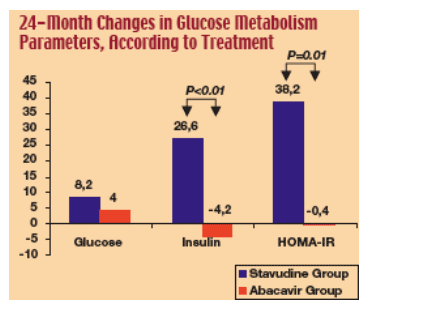
Abacavir was associated with significant declines in IL-18 (median 524 to 316) & sTNFR2 (median 10.95 to 5.17); but, adiponectin did not significantly decline: median 15.72 at baseline & 13.76 at month 24 (ns).
24-Month Changes in Cytokines, Comparing Abacavir to d4T:
Adiponectin: there was a significant (p=0.01) difference between abacavir vs d4T over the 24 months. Adiponectin declined by 61% for d4T. There was no significance in changes for IL-18 & sTNFR2 between abacavir & d4T. IL-18 declined by 35% for d4T vs 38% for abacavir. sTNFR2 declined by 36% for d4T & 43% for abacavir.
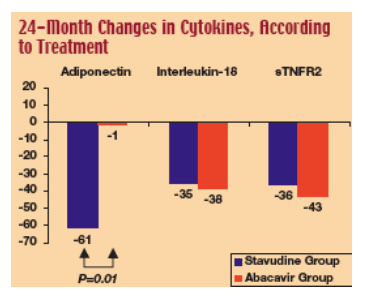
Patients with lipoatrophy* (n=8) were more likely to develop abnormalities in glucose parameters:
--increased glucose by 4.9%
--increased insulin by 24%
--increased HOMA-IR by 33%
suggesting that body changes may be cause glucose abnormalities & diabetes.
*lipoatrophy was defined as 2 or more clinical signs: lipoatrophy was evaluated at 4 anatomical sites: face, arms, legs, buttocks. Although it was not mentioned in the poster, based on information from previous reports on the study my understanding is that DEXAs were used.
For patients who did not have lipoatrophy (n=55)*:
--glucose declined by 4.9%
--insulin declined by 0.9%
--HOMA-IR declined by 8.3%
Comparing patients with lipoatrophy (n=8) to other patients (n=55): there was not a significant difference in changes over 24 months in glucose between patients with or without lipoatrophy; but patients with lipoatrophy had significantly worse changes in insulin (p=0.016) & HOMA-IR (p=0.033).
Patients with lipodystrophy (n=7) defined as lipodystrophy clinical signs & waist-to-hip ratio increases over the mean had 72% increase in insulin & 87% increase in HOMA-IR (presumably mean or median increase). This compared to decreases of 9-10% for patients without lipodystrophy. Differences were significant between patients groups with & without lipodystrophy. Regarding changes in cytokines, there was a greater decrease in adiponectin levels from baseline to month 24 for the patients with lipodystrophy (-52% vs -30%). See details at end of report below. Regarding IL-18 & sTNFR2 see details at end of report. There did not appear to be differences in changes between patients with or without lipodystrophy. But IL-18 & sTNFR2 decreased by 40-50% for both groups.
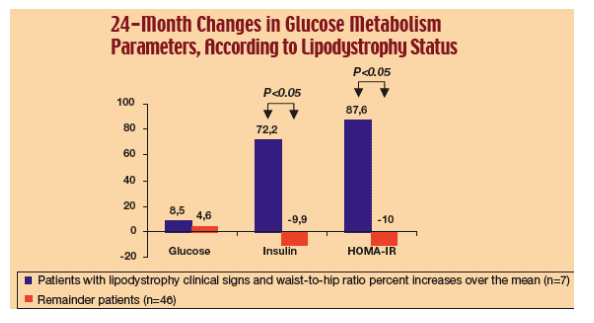
CYTOKINES
Patients with lipoatrophy (n=8):
--Adiponectin declined by 48.8% from 14.21 at baseline to 6.13 at month 24.
--IL-18 declined by 26% from 580.2 at baseline to 416.2 at month 24.
--sTNFr declined by 25% from 10.59 at baseline to 8.32 at month 24.
Patients without lipoatrophy (n=55):
--adiponectin declined by 18.8% from 13.25 at baseline to 10.24 at month 24.
--IL-18 declined by 38.6% from 519 at baseline to 316 at month 24.
--sTNFR2 declined by 37% from 11.27 at baseline to 6.10 at month 24.
Patients with lipoatrophy had significantly greater declines in adiponectin (p=0.049) and sTNFR2 (p=0.032) but the difference in changes regarding sTNFR2 was not significant.
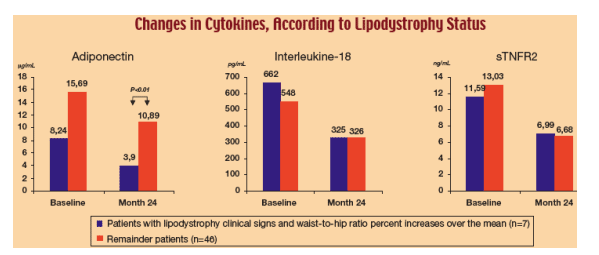
In the ABCDE Study 237 treatment-naive patients were randomized to receive d4T (30-40mg twice daily) + 3TC + efavirenz OR abacavir (300mg daily) + 3TC + efavirenz. The study was designed to compare the different impact of d4T vs abacavir regarding body changes, and lipids. At baseline mean CD4 count was 210 and VL was 5.2 logs, similar in both groups. 80% of participants were men.
Previously at CROI 2005, week 96 results reported d4T was associated with a decrease in limb fat but abacavir showed an increase in limb fat. Abacavir had a better lipid profile: lower triglycerides, greater HDL and apolipoprotein (ApoA1), and greater reduction in total cholesterol/HDL (TC:hdL) ratio. None of this was unexpected. The percent <50 c/ml at week 96 was 47% for d4T arm vs 61% for abacavir arm (p=.05). Limb fat increased at week 48 by 686 g when using abacavir and decreased by 1164 g when using d4T (p=0.001). At week 96 limb fat was +913 for patients using abacavir and -1579 for patients using d4T (p<0.001).
Using DEXAs, 19 patients (23%) on d4T had fat accumulation in the belly and 9 (10%) had so on abacavir, but this difference was not significant. 21 patients (26%) taking d4T had fat loss in the face vs 3 (3.6%) taking abacavir (P<0.001). Similar results were seen regarding fat loss in the arms (17% vs 1.3%, buttocks (25% vs 2.4%), and legs (23% vs 1%), and these differences were significant.
At IAS-Rio, study authors reported changes in insulin resistance markers and cytokines after 24 months in the study.

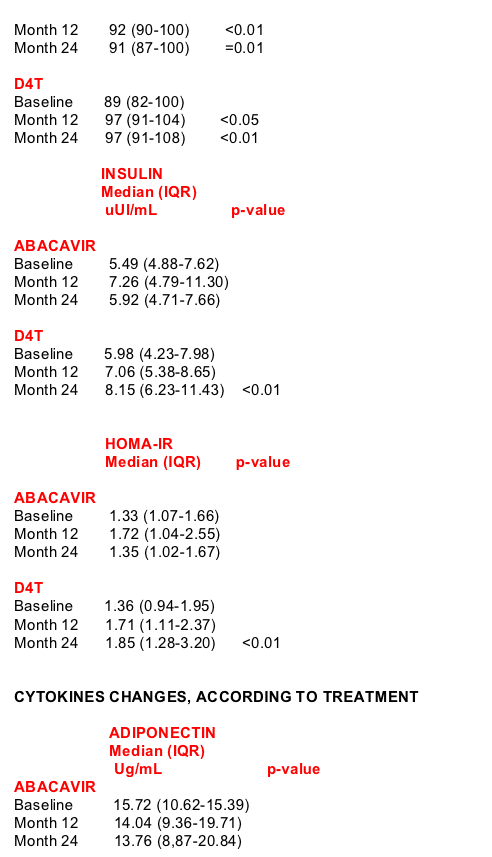
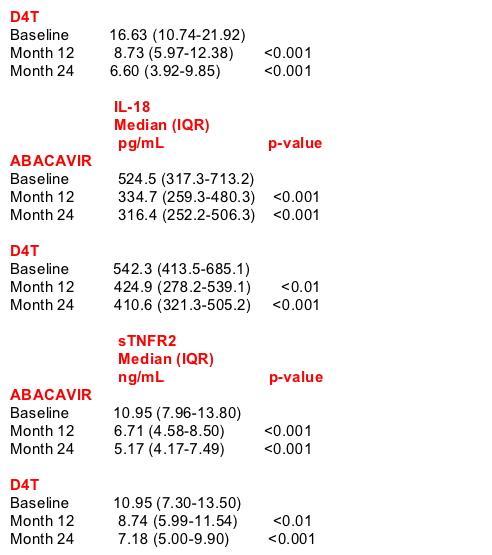

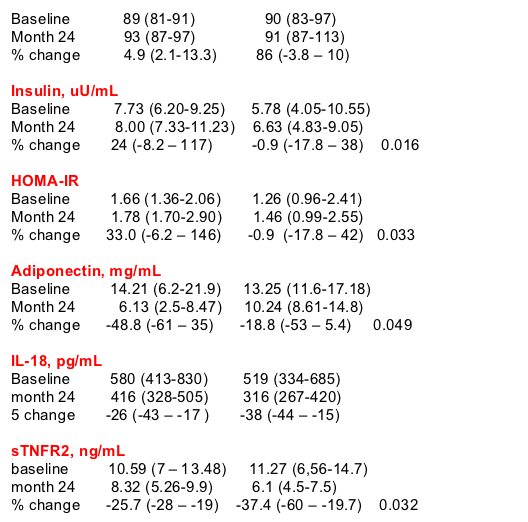
24-MONTH CHANGES IN GLUCOSE METABOLISM PARAMETERS, ACCORDING TO LIPODYSTROPHY STATUS
Patients with lipodystrophy clinical signs and waist-to-hip percent increases over the mean (n=7). Remainder patients (n=46). It appears that this analysis is different & includes patients with fat accumulation while the other analysis looks at patients with lipoatrophy.
Patients with lipodystrophy & waist-to-hip ratio had greater increases in insulin and HOMA-IR compared to the Remainder Patients, who I assume did not have these lipodystrophy changes. Insulin increase was 72.2% for lipodytrophic patients vs a decrease of -9.9% for Remainder Patients (p<0.05). HOMA-IR increase was 87.6% for lipodytrophic patients vs -10% for Remainder Patients (p<0.05).
CHANGES IN CYTOKINES, ACCORDING to LYPODYSTROPHY STATUS
As mentioned at the top of the report adiponectin decreased for both patient groups with and without lipodystrophy, but the decrease was 52% for lipodystrophic patients and 30% for Remainder Patients, this difference in change was significant (p<0.01).
ADIPONECTIN
Lipodystrophic patients:
8.25 at baseline
3.9 at month 24
Remainder Patients:
15.69 at baseline
10.89 at month 24
IL-18
Lipodytrophic patients: 662 at baseline
Remainder Patients: 548
month 24:
325 for lipodystrophic
326 for Remainder
sTNFR2
baseline:
11.59 for lipodystrophic
13.03 for Remainder
month 24:
6.99 for lipodystrophic
6.68 for remainder.
|
| |
|
 |
 |
|
|